|
|
| |
| |
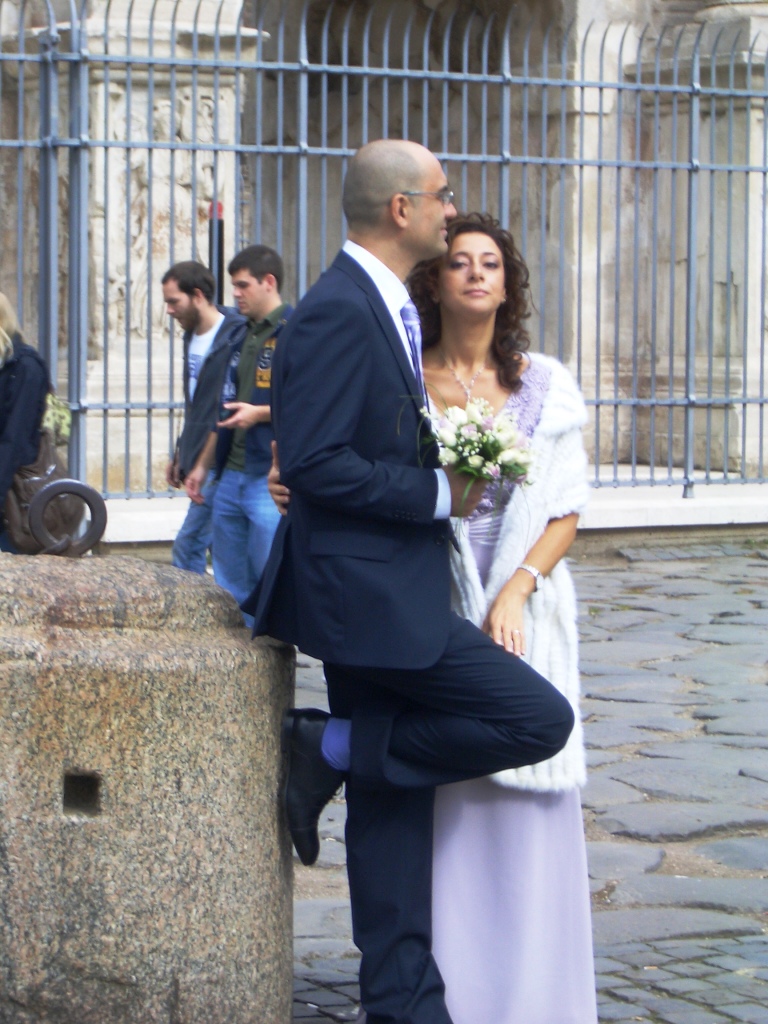
Modern couple posing for wedding photos.
The Arch of Constantine, Rome.
|
|
Roman Women: an Introduction
Rome: On a visit to the Roman Colosseum and the Forum, I noticed a stylish young woman with a trendy man.
They stuck out among the
unglamorous tourist crowds. Perhaps they were models, posing for wedding photos under the ancient Arch of Constantine,
near the Colosseum. Constantine's Arch was dedicated in AD 315 to the
Emperor Constantine as a war memorial, and is a favorite spot for
photography.
Women in the 4th century, women in the 21st.
Wouldn't women in ancient Rome be nearly like us--looking for security, status, maybe
love?
Family was important to them. Surely like us
they thought about loss, growing older, values to teach their children.
On the other hand, ancient Rome's history meant choices available for
women were far different from ours today.
Off I went to find out more.
|
|
|
|
|
|
|
|
|
My first stop: The Palatine Museum |
|
|
|
(directly above the Roman
Forum.) |
|
|
| |
|
|
Since the Arch of Constantine
and the Colosseum are close to the Palatine Hill, I
started at the ticket office entrance to the
Palatine Hill. Bring your imagination, as the
signs of ancient Rome are underground, out of sight,
or in tiny fragments.
Soon I was grumbling: too much
rubble, too dusty, too hot, too dry; too few signs,
crowds too large, sore feet. Whine, whine, whine,
the quintessential
tourist.
But then the small,
old-fashioned Palatine Museum opened up before me on
the south side of the Palatine.
The Palatine Museum was an unexpected treat, mostly of
artifacts found on the Palatine itself. Lots
of marble portrait busts, once painted, of
Roman upper class women. |
|
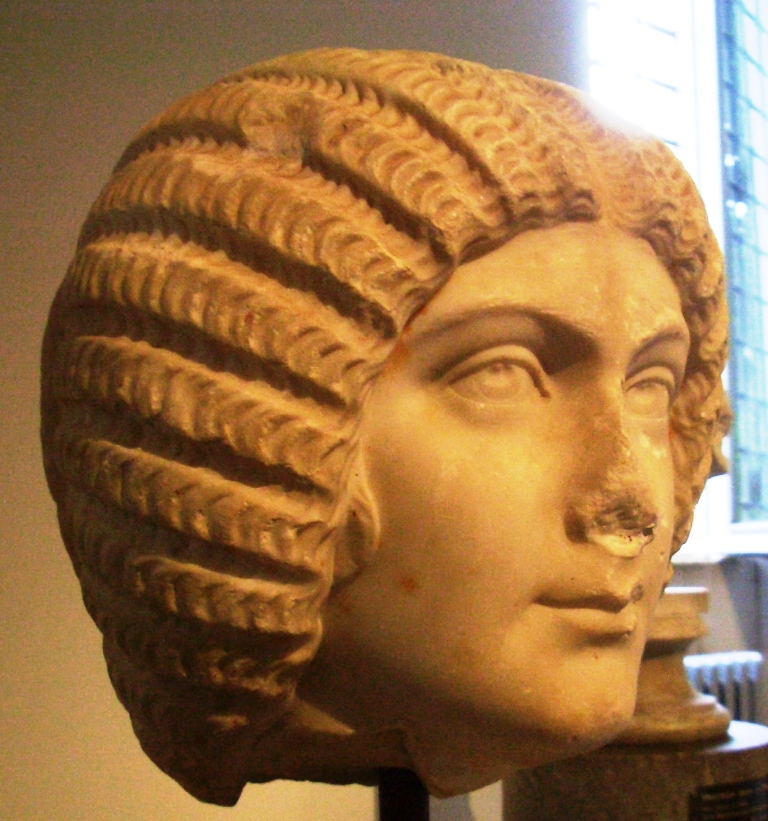
Julia Domna.
Late 2nd c AD. Wife of Emperor Septimius Severus
and mother of Emperors Caracalla and Geta.
Palatine Museum. |
| |
|
|
I was in need of a European
style hairdo. Hmmm--maybe the styles on these busts
could inspire.
One look told me I would also need the horde of assistants employed by upper-class Romans
to keep their looks impeccable.
We know that Livia, the wife of the first Roman Emperor
and known for her elegant modesty, had an
enormous specialized staff. Some servants, slaves,
or professionals were for her clothes, shoes and religious garments.
More were for needed for her
hair and make-up. Yet others took care of her jewelry and
ornaments.
Galen, the Greek physician of the 2nd c,
approved of cosmetics to prolong beauty but not
unnatural procedures, such as dying your hair or
bleaching your skin.
To create a modest appearance
was indeed costly!
Which was the whole point
for the Romans.
|
|

Hairdressing.
Painted fresco panel from Herculaneum,
Italy. 1st c AD. Naples, National Archaeological
Museum. courtesy:
Barbara McManus
VROMA
|
|
|
|
|
Second stop: The
Capitoline Museum |
|
|
|
On the Campodiglia above the Roman Forum. |
|
|
| |
|
|
I walked down the Palatine Hill,
pausing to look at the stunning views. From the top,
you can see the
Colosseum, the various Arches, and the Roman Forum. Then up the
Capitoline Hill I went to the Capitoline Museums.
The Capitoline Museum has an
entire building devoted to marble statuary and
portrait busts of all kinds of Romans.
The hairstyles of the women of
the Flavian
period are jaw-droppers-- lots of rings and curls
tightly woven and close to the face.
A style
that must have taken the hairdresser hours to
perfect.
All kinds of fittings, sometimes of gold,
were fashioned to secure the hairnet needed for
these hairstyles. Some hairnets were even woven with
gold thread. Another device, the hairpin, might be
carved exquisitely in bone.
How the rich did live...
More
photos of hairstyles:
Glorious Roman Hairstyle Photos
You-Tube:
How to make a Roman
hairstyle: ( Empress Sabina: Ancient Roman
Hairdressing," by professional hairstyle-archeologist Janet Stephens)
|
|

Bust, c
80 AD. Flavian period hairdo. Capitoline
Museums, Rome
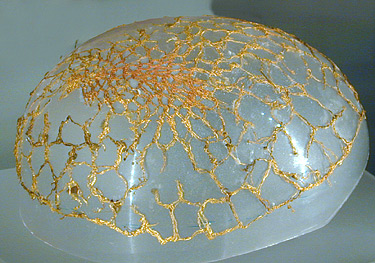
Hairnet
woven from gold thread.
Palazzo Massimo,
Rome.
Photo courtesy VROMA, A. Raia.
|
|
|
|
|
|
|
|
|
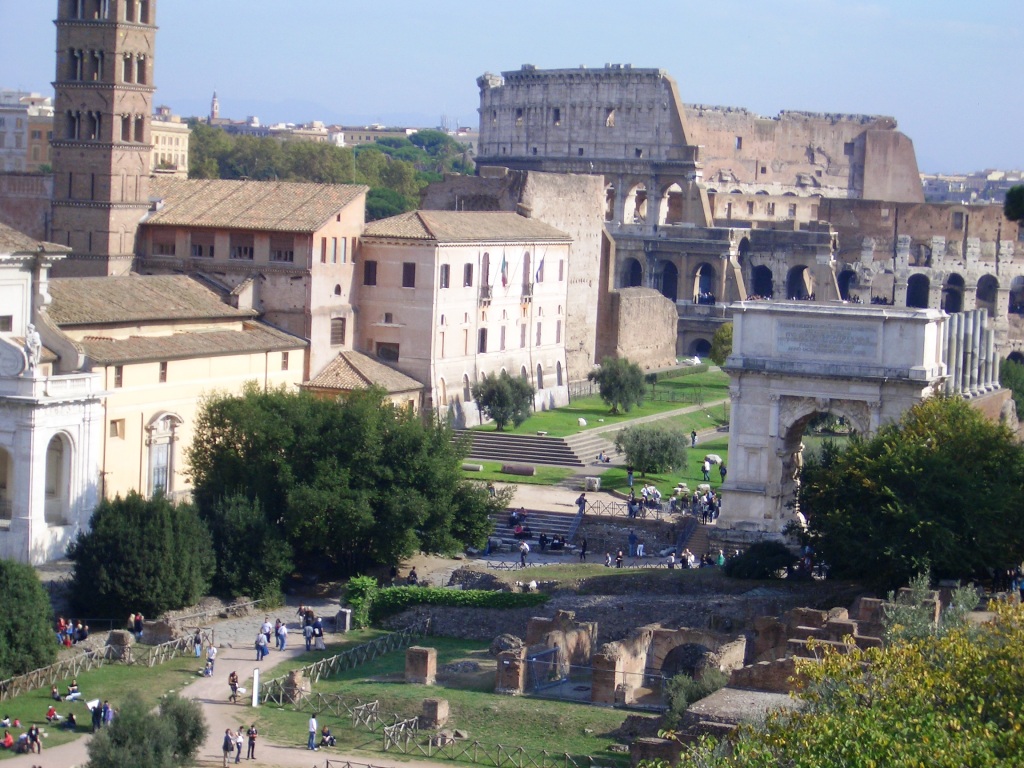
From
the top of the Palatine Hill, looking toward the
Colosseum. |
|
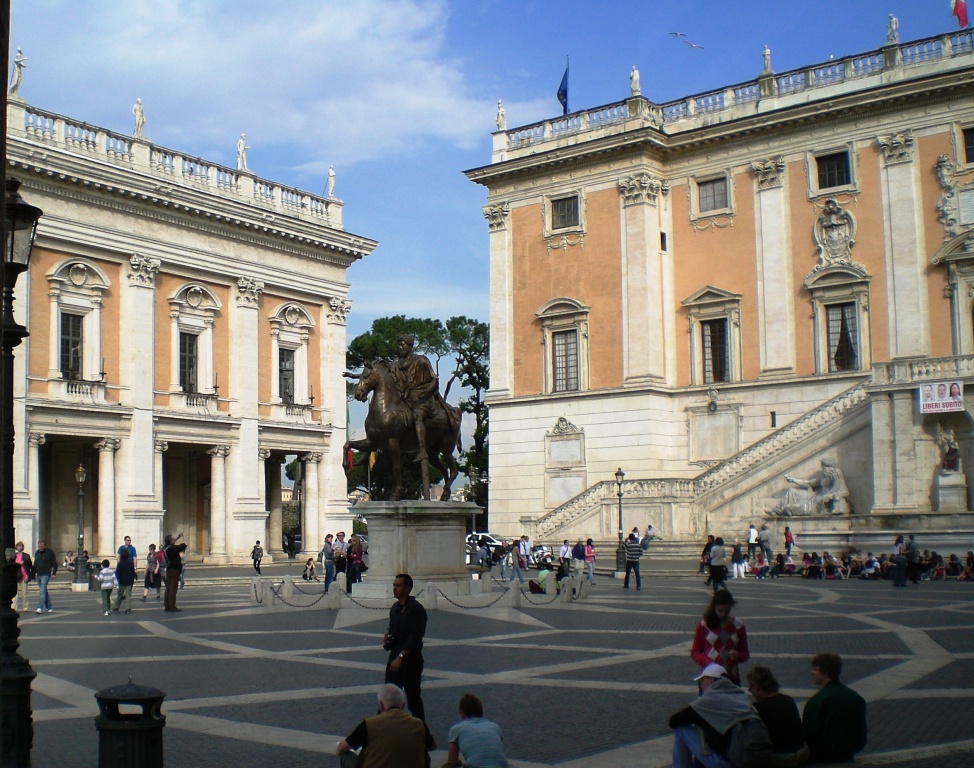
Capitoline Museums, Rome. |
|
|
|
|
|
|
|
|
Third Stop: Palazzo Massimo National Museum of Rome |
|
|
| |
|
|
After a restorative glass of
wine at the Capitoline Museum cafe (we are in Italy,
after all), I continued by bus to the Palazzo
Massimo. It's near the central train station and the
Baths of Diocletian, not the most pleasant of
tourist areas but safe enough. The Palazzo,
one of the five branches of the National Museum of
Rome, houses one of the world's leading collections
of classical art on four floors.
Minerva is the first woman to greet
me. Twice as large
as life, she's a colorful Numidian yellow.
Ancient
portrait busts often seem lifeless to modern
eyes. They have too much dignity and not enough humanity, nothing
but cold marble. That's because the color has
disappeared over the centuries. Many of them were
originally painted in brilliant colors, as this
Minerva hints at.
In Roman religion, Minerva, the daughter of
Jupiter, was the original all-purpose
super-goddess. She was the virgin goddess of poetry,
medicine, and wisdom, as well as the inventor of
music.
|
|
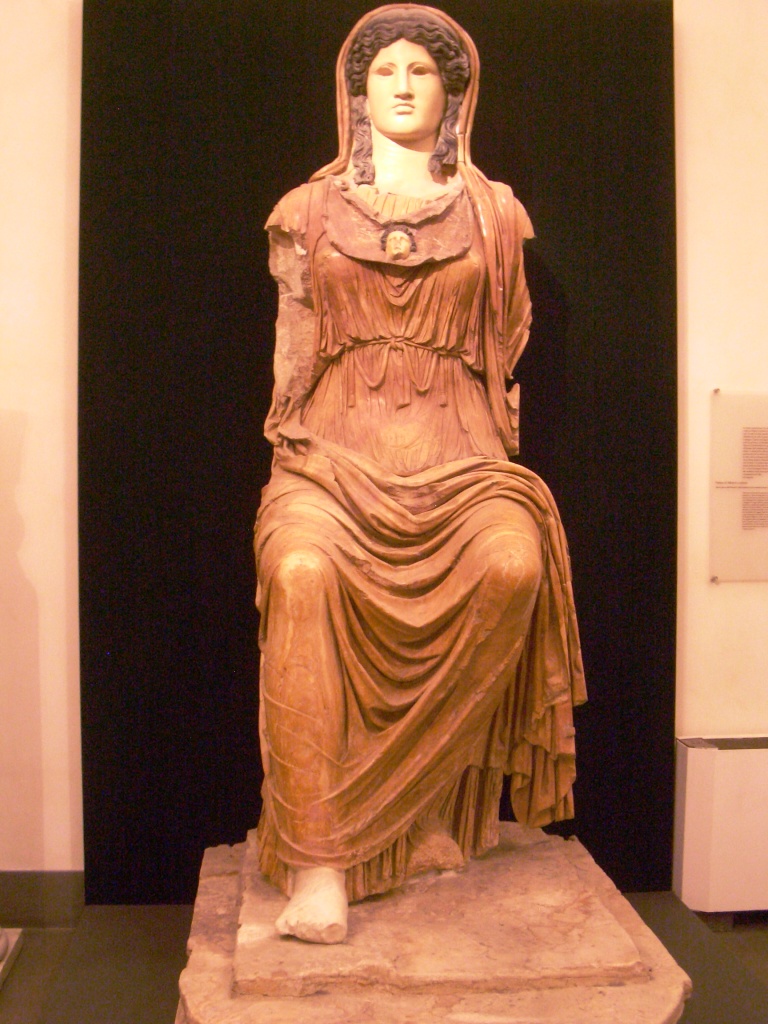 Minerva.
Marble. 1st c BC. Palazzo Massimo. Minerva.
Marble. 1st c BC. Palazzo Massimo. |
|
|
|
|
|
|
|
|
|
|
|
|
I particularly liked
the bust of Antonia the Younger,
pictured right, because of who she represents.
Antonia was a type of Roman woman who pop up a lot
in the histories about the Roman
Empire---women deeply involved in the tangled politics
of the imperial family.
Antonia the Younger was the daughter of Mark Anthony and
Octavia. Octavia was Emperor Augustus' beloved sister
and
the mother of Emperor Claudius. Antonia never had a
chance to know her father, Mark Anthony, since he
was killed in defeat in the civil war with Augustus.
(Cleopatra, Anthony's "Eqyptian Queen" perished at
the same time, by suicide.)
Antonia was
raised by her mother Octavia, her uncle Emperor Augustus,
and his wife, the even more news-worthy Empress
Livia. What a childhood she must have had.
Antonia's
daughter, Livilla, allegedly poisoned her own husband.
He was the son
of the then-Emperor Tiberius. Scandal in the
imperial family--what to do? The "guilty" daughter was handed over to
mother Antonia. Antonia supposedly imprisoned her offending daughter
in a room and starved her to death.
True? Who knows? Poison was seen by the ancient male
writers as the ubiquitous weapon of women,
especially in politically-inspired deaths. |
|
 Antonia
the Younger.
1st c BC
Marble. Palazzo Massimo. Antonia
the Younger.
1st c BC
Marble. Palazzo Massimo.
|
|
|
|
|
|
|
|
|
|
|
|
|
Livia, the
wife of the first Emperor Augustus, owned a villa
outside Rome at Prima Porta about 8 miles north of
Rome.
Frescoes of her garden were installed in a subterranean dining room
in the villa.
The dining room was discovered only in 1863,
frescoes still intact.
The frescoes were detached in 1952 and reinstalled in the Palazzo
Massimo. They are truly magnificent and show
that Livia had exquisite taste.
More photos of the
Garden Frescoes from Livia's Villa from Flickr. |
|
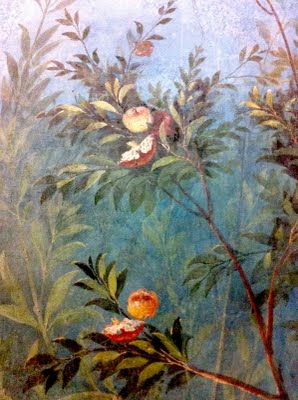 Livia's
Garden,
fresco detail of from the
dining room at Livia's Villa, Rome. 1st c AD. Fresco
painting. Installed at the National Museum of
Rome, Palazzo Massimo, Rome. Livia's
Garden,
fresco detail of from the
dining room at Livia's Villa, Rome. 1st c AD. Fresco
painting. Installed at the National Museum of
Rome, Palazzo Massimo, Rome. |
| |
|
|
|
|
|
|
| |
|
|
|
After these three major museums,
it was time to return to
Trastevere and a night out at
Osteria Da
Fernanda. |
|
|
| |
|
|
|
Updated 04-August-2015. You may contact me, Nancy Padgett, at
NJPadgett@gmail.com |
|
|
|
|